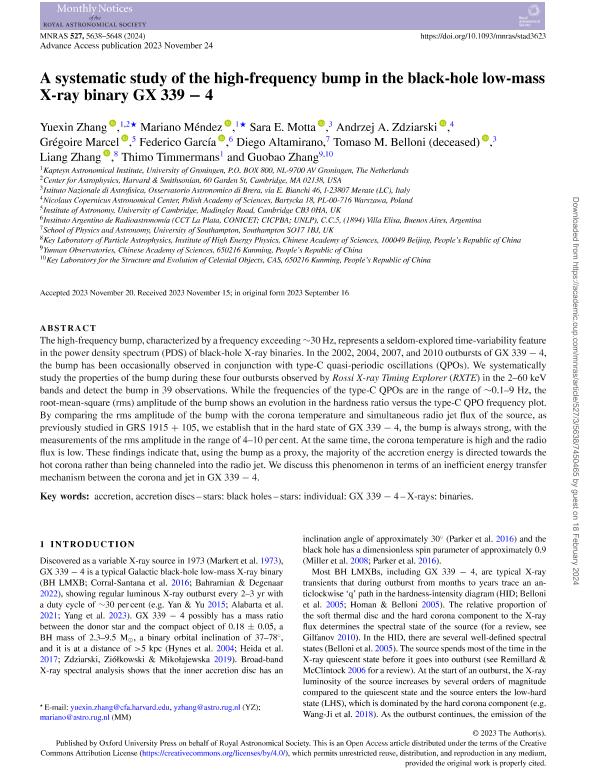Artículo
A systematic study of the high-frequency bump in the black-hole low-mass X-ray binary GX 339 -4
Zhang, Yuexin; Méndez, Mariano; Motta, Sara E.; Zdziarski, Andrzej A.; Marcel, Grégoire; García, Federico ; Altamirano, Diego; Belloni, Tomaso M.; Zhang, Liang; Timmermans, Thimo; Zhang, Guobao
; Altamirano, Diego; Belloni, Tomaso M.; Zhang, Liang; Timmermans, Thimo; Zhang, Guobao
 ; Altamirano, Diego; Belloni, Tomaso M.; Zhang, Liang; Timmermans, Thimo; Zhang, Guobao
; Altamirano, Diego; Belloni, Tomaso M.; Zhang, Liang; Timmermans, Thimo; Zhang, Guobao
Fecha de publicación:
01/2024
Editorial:
Wiley Blackwell Publishing, Inc
Revista:
Monthly Notices of the Royal Astronomical Society
ISSN:
0035-8711
Idioma:
Inglés
Tipo de recurso:
Artículo publicado
Clasificación temática:
Resumen
The high-frequency bump, characterized by a frequency exceeding ∼30 Hz, represents a seldom-explored time-variability feature in the power density spectrum (PDS) of black-hole X-ray binaries. In the 2002, 2004, 2007, and 2010 outbursts of GX 339 -4, the bump has been occasionally observed in conjunction with type-C quasi-periodic oscillations (QPOs). We systematically study the properties of the bump during these four outbursts observed by Rossi X-ray Timing Explorer ( RXTE ) in the 2-60 keV bands and detect the bump in 39 observations. While the frequencies of the type-C QPOs are in the range of ∼0.1-9 Hz, the root-mean-square (rms) amplitude of the bump shows an evolution in the hardness ratio versus the type-C QPO frequency plot. By comparing the rms amplitude of the bump with the corona temperature and simultaneous radio jet flux of the source, as previously studied in GRS 1915 + 105, we establish that in the hard state of GX 339 -4, the bump is al w ays strong, with the measurements of the rms amplitude in the range of 4-10 per cent. At the same time, the corona temperature is high and the radio flux is low. These findings indicate that, using the bump as a proxy, the majority of the accretion energy is directed towards the hot corona rather than being channeled into the radio jet. We discuss this phenomenon in terms of an inefficient energy transfer mechanism between the corona and jet in GX 339 -4.
Archivos asociados
Licencia
Identificadores
Colecciones
Articulos(IAR)
Articulos de INST.ARG.DE RADIOASTRONOMIA (I)
Articulos de INST.ARG.DE RADIOASTRONOMIA (I)
Citación
Zhang, Yuexin; Méndez, Mariano; Motta, Sara E.; Zdziarski, Andrzej A.; Marcel, Grégoire; et al.; A systematic study of the high-frequency bump in the black-hole low-mass X-ray binary GX 339 -4; Wiley Blackwell Publishing, Inc; Monthly Notices of the Royal Astronomical Society; 527; 3; 1-2024; 5638-5648
Compartir
Altmétricas



